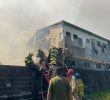(first of three parts)
By GERMELINA A. LACORTE
Davao Today
First, their groups have been tagged as the legal fronts of the Communist New People’s Army. Then, top military officials make public statements suggesting they’re enemies of the state. Finally, before anyone could stop to consider, they are killed.
This pattern emerges in the extrajudicial killings of activists in the country, which have become more pronounced in Davao City and neighboring provinces of Compostela Valley as the government’s 2010 deadline to wipe out the Communist insurgency looms.
Interviews with survivors and victims’ relatives during the second quarter of this year reveal a pattern of death threats, a period of surveillance�most often involving motorcycles or tinted vehicles with �fake� plate numbers parked near the victims� houses or place of works�before attackers close in on their victims and kill them.
After Bayan Muna Rep. Satur Ocampo exposed the existence of a military document linking some individuals and civil society groups to the Communist movement, Davao Today finds it urgent to look into the pattern of the killings of activists in this part of the country.
In Compostela Valley alone, where government soldiers suffered severe beatings from the Communist New People�s Army (NPA), five died in a span of six months in the last quarter of 2008. This does not include yet the three killed in Davao City and Compostela Valley this year, the latest of which was Dr. Rogelio Pe�era, the epidemiologist who died in Davao City on his way home last week.
Human rights group relate the killings to a document called Oplan Bantay Laya, a military campaign to end the insurgency by 2010, but which included the targeting of progressive groups as a strategy. This is a charge that the military denies.
On May 15, last year, peasant leader Celso Pojas was preparing for his trip to Compostela town of Compostela Valley, where peasant members of the Kilusang Magbubukid ng Pilipinas (KMP) were fleeing their houses because of increased presence of soldiers pursuing the NPA in the area.
In the early morning, he was stirring his coffee inside the KMP office in Maa, when he noticed that he had run out of cigarettes and decided to go out to a store across the street to buy.
But just minutes after he left the table, gunshots rang and his officemates heard his last cry for help. It was close to 6:00 am, the time his officemates noted, they were supposed to leave for Compostela.
Pojas died of gunshot wounds on his ribs and left elbow. He was 81st on the Karapatan list of activists killed since Arroyo came to power in 2001.Only two months after Pojas was killed, Maximo Baranda, a leader of the militant Kilusang Mayo Uno, was killed in the riverside quarry, in San Jose, Compostela town in Compostela Valley.
Then, barely a month later, Roel Dotarot, the Monkayo coordinator of the partylist group Bayan Muna, was gunned down by men on motorcycle in barangay Banlag of Monkayo town.
Dotarot�s killing preceded the assassination of three more Bayan Muna coordinators in just a span of four months: Danilo Cualbar, Bayan Muna cluster coordinator in Compostela town; Rolando Antolihao, barangay coordinator of Kapalong town, killed only four days after; and Isabelo Celing, barangay coordinator of Bayan Muna in Poblacion, Monkayo town. Celing was killed on December 2008.
Kelly Delgado, secretary-general of the human rights group Karapatan in Southern Mindanao, pointed out that Baranda, Dotarot, Cualbar, Antolihao and even Celing had something in common with Pojas. They were all involved in helping out peasants affected by the militarization in Compostela Valley areas to evacuate. Among those that Pojas was supposed to help before he died was a couple and their newborn son who fled Bermuda on foot on the night of May 12 after the husband was beaten and tortured by soldiers on May 2.
Statements from the military weeks before Pojas� death branded his group as �legal front� of Communists out to discredit the army.
Pojas and the rest were also involved in the fact-finding teams to Baganga, Davao Oriental, where increased armed encounters between the military and the NPAs were noted and where eventual aerial bombardment by soldiers on villages forced civilians to flee.
The victims also joined relief and fact-finding missions in Crossing Taytayan in New Bataan, the military�s �staging point� in the offensives against the NPAs.
Extrajudicial Killings









